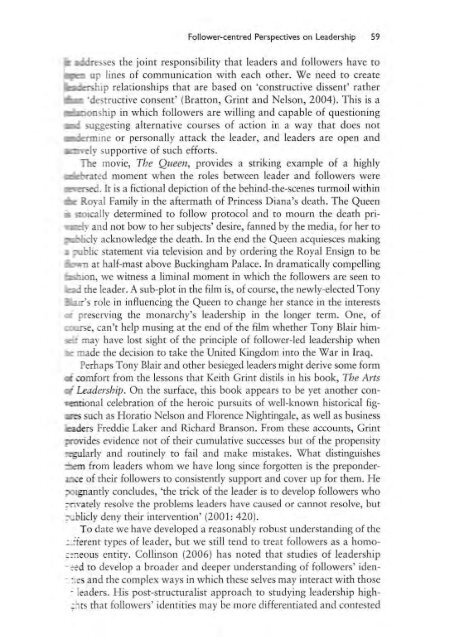Jackson Parry - Leadership, Chp 3, 41-60.pdf
Jackson Parry - Leadership, Chp 3, 41-60.pdf
Jackson Parry - Leadership, Chp 3, 41-60.pdf
- No tags were found...
Create successful ePaper yourself
Turn your PDF publications into a flip-book with our unique Google optimized e-Paper software.
Foll ower-centred Perspectives on <strong>Leadership</strong> 59addresses the joint responsibility that leaders and followers have to,::~up lines of comm unication with each other. We need to create• - \-,ship relationsh ips that are based on 'constructive dissent' rather~ 'destructive consent' (Bratton, Grint and Nelson, 2004 ). This is a.ImoDship in which follO\\'ers are wi ll ing and capable of questioningsuggesting alternative courses of action in a way that does not'hlu ine or persona ll y attack the leader, and leaders are open and.. x ... ely supportive of such efforts.The movie, The Queen, provides a striking example of a highlyadbaated moment when the roles between leader and fo llowers wereasused. It is a fictional depiction of the behind-the-scenes turmoil withinRoyal Family in the aftermath of Princess Diana's death. The Queen• stOically determined to fo tlow protocol and to mourn the death pri~ and not bow to her subjects' desire, fanned by the media, for her to~ Iy acknowledge the death. In the end the Queen acquiesces makinga public statement via television and by ordering the Royal Ensign to be..-n at half-mast above Buckingham Palace. In dramatically compellingbs!uon, we witness a liminal moment in which the fo llowers are seen tolead the leader. A sub-plot in the film is, of course, the newly-elected TonyIbrr·s role in infl uencing the Queen to change her stance in the interestsei preserving the monarchy's leadership in rhe longe r term. One, ofQ1lll"Se, can't help musing at the end of the film \ .... hether Tony Blair himiidimay have lost sight of the principle of fo llower-led leadership whenk made the decision to take the United Ki ngdom into the \Var in Iraq.Perhaps Tony Blair and other besieged leaders might de rive some form.. comfort from the lessons that Ke ith Grint distils in his book, The Arts.{ <strong>Leadership</strong>. On the surface, this book appears to be yet another COI1 --=nrional celebration of the heroic pursuits of well-known historical figeessuch as Horatio Nelson and Florence Nightingale, as well as business!taders Fredd ie Lakef and Rjchard Branson. From these accounts, Grint~vi des evidence not of theif cumu lative successes but of the propensity,.,ogularly and rominely to fail and make mistakes. What distinguishes::.!m from leaders whom we have long since forgotten is the prepollderoceof their fo llowers [Q consistentl y support and cover lip for them . He;'Olgnan tly concludes, 'the trick of the leader is [Q develop followers who;nvately resolve the problems leaders have caused or cannot resolve, but:\lblicly deny their intervention ' (2001: 420).To date we have developed a reasonably robust understanding of the':"':.£ferent types of leader, but we still tend to treat fo llowers as a homo~~n eo u s entity. Collinson (2006) has noted that studies of leadership- ~ d to develop a broader and deeper understanding of fo llowers' iden-- ::es and the complex ways in which these selves may interact with those- leaders. His post-stru cturalist approach to study ing leadership high-.::us that followers' identities may be more differentiated and contested
















